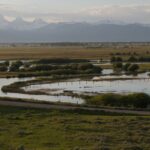Negligent Decision Ignites Deadly Maui Wildfires
In this comprehensive exploration, we delve into the allegations against Hawaiian Electric Industries for its alleged negligence that sparked the devastating Maui wildfires. As we scrutinize the ignored warnings and inadequate infrastructure, we also spotlight the class action lawsuit aiming to represent those affected by the Lahaina Fire. This piece serves as a critical resource for those impacted and an insightful read for those intrigued by the complexities of class action legal proceedings.

Background of Negligent Decision
The Hawaiian Electric Industries' decision to leave power lines energized during high winds and fire-prone conditions instigated the devastating Maui wildfires, according to the proposed class action lawsuit. The potential legal implications of this decision are extensive, with the lawsuit claiming negligence and failure to implement standard safety measures. The impact on the community has been devastating, with thousands displaced and suffering from physical injuries and psychological trauma. The defendants' alleged negligent actions have not only caused unprecedented destruction but also put the lives of Maui residents at risk. This incident underlines the need for stringent regulations and proactive measures in managing power lines, particularly in high-risk areas, to prevent such disasters in the future.
Lawsuit Against Hawaiian Electric Industries
Numerous victims of the Maui wildfires have initiated a class action lawsuit against Hawaiian Electric Industries, alleging the company's negligence led to the catastrophic event. The suit claims that the negligence took three main forms:
- Hawaiian Electric Industries' decision to leave power lines energized in high winds and fire risk conditions, which allegedly ignited the wildfires.
- A failure to implement a power-shutoff strategy, a common practice in areas prone to wildfires, despite the clear vulnerability of Maui.
- A lack of proper maintenance of the infrastructure, including clearing vegetation and repairing equipment, which heightened the fire risk.
The impact on affected individuals has been devastating, with thousands displaced and suffering from injuries and mental stress. The lawsuit seeks to hold the company accountable for these damages.
Source of Wildfire Ignition
Allegedly, the source of wildfire ignition can be traced back to Hawaiian Electric Industries' decision to keep power lines energized during dangerous high wind and fire risk conditions. This negligent decision, ignoring key ignition factors, resulted in catastrophic wildfires on the island of Maui.
| Ignition Factors | Hawaiian Electric's Actions | Preventative Measures |
|---|---|---|
| High Wind | Kept power lines energized | De-energize power lines |
| Fire Risk Conditions | Ignored warnings | Heed meteorological warnings |
| Vegetation Near Power Lines | Insufficient clearance | Regular trimming and clearance |
| Faulty Equipment | Poor maintenance | Regular inspection and repair |
| Lack of Shutdown Protocol | No procedure in place | Establish and implement shutdown strategy |
The company's failure to consider these preventative measures and its dismissal of known ignition factors have been named as the primary causes of the deadly Maui wildfires.
Consequences of Ignored Warnings
In the face of such blatant disregard for safety protocols, over a thousand individuals were displaced, enduring severe burns, smoke inhalation, and psychological trauma due to the devastating Maui wildfires. These disturbing outcomes underscore the severe consequences of inadequate preparation.
- The immediate havoc wrought by the fires not only led to physical injuries but also caused significant property and environmental damage, leaving many homeless and destitute.
- The long term impact of the wildfires will be felt in the community for years to come, with the restoration of homes, businesses, and natural habitats requiring substantial time and resources.
- The psychological toll on victims, witnessing their homes and possessions engulfed in flames, is immeasurable and often overlooked in the aftermath of such disasters.
Human-made Disaster's Impact
The catastrophic aftermath of this human-made disaster has not only ignited vast physical destruction but also sparked profound sociological and psychological consequences within the Maui community. The wildfire's impact on wildlife has been devastating, with numerous habitats obliterated and countless creatures displaced or perished. This catastrophe has also instigated long-term environmental consequences. The rich biodiversity of Maui is under severe threat due to the destruction of native flora and fauna. Furthermore, the ash and toxins released into the air and soil have a prolonged, detrimental effect on the health of the ecosystem. The disaster's ripple effects extend beyond immediate loss, making recovery a complex, long-term process for both the community and the environment.
Power-Shutoff Strategy's Importance
Adopting a robust power-shutoff strategy during extreme weather conditions is crucial to prevent the ignition of disastrous wildfires. The importance of proactive measures cannot be overstated. The lessons from California wildfires highlight the need for a clear action plan.
- Proactive Measures: Utilities must proactively de-energize power lines during high-risk conditions, reducing fire ignition chances.
- California's Strategy: Learning from California's approach, implementing public safety power shutoffs during Red Flag warnings is essential.
- Infrastructure Upgrades: Using modern technologies to build fire-resistant infrastructure is another crucial step.
Ignoring these steps, as seen in the Maui wildfires, leads to dire consequences. Therefore, the significance of a power-shutoff strategy in preventing wildfires is paramount.
Utilities' Response to Extreme Weather
Despite the importance of a proactive power-shutoff strategy during extreme weather conditions, utilities' response has often been found lacking, as exemplified by the devastating Maui wildfires. The response effectiveness was undermined by the failure to adopt a power-shutoff program despite known risks, leading to catastrophic consequences. The absence of a thorough risk assessment resulted in negligence to de-energize power lines during high winds, contributing to the ignition of the wildfires. Furthermore, inadequate maintenance of infrastructure, including vegetation clearance around power lines, amplified the danger. The utilities' response to extreme weather, thus, raises serious concerns about their preparedness and commitment to mitigate potential risks, highlighting the urgent need for improved strategies and protocols.
Maui's Vulnerability to Wildfires
Drawing on the lessons from the utilities' inadequate response to extreme weather, we turn our attention to the inherent vulnerability of Maui to wildfires. The impact of climate change has intensified wildfire risk in Maui, with warmer temperatures, drier conditions, and stronger winds creating a perfect storm for ignition.
- Maui's wildfire prevention measures have struggled to keep pace with these escalating threats. Despite some efforts, the scale of prevention and mitigation activities has not matched the scale of the risk.
- Historic land-use practices have resulted in an unnatural buildup of vegetation, creating ample fuel for wildfires.
- The island's topography, characterized by steep slopes and deep valleys, further increases susceptibility to rapid fire spread. Consequently, proactive, climate-informed measures are urgently needed to reduce Maui's wildfire vulnerability.
Repercussions of Reckless Strategy
The sheer magnitude of the repercussions from the defendants' reckless strategy is epitomized by the extensive property damage, business losses, and personal injuries endured by thousands of Maui residents. The implications of inadequate preparation are apparent in the catastrophic damage caused by the negligent decision to leave power lines energized during high-risk conditions.
| Impact Area | Description | Ramifications |
|---|---|---|
| Property Damage | Numerous homes and businesses destroyed | Economic downturn, homelessness |
| Business Losses | Commercial entities severely impacted | Loss of jobs, decreased local economy |
| Personal Injuries | Thousands suffering various injuries | Healthcare burden, psychological trauma |
The legal ramifications of this negligent decision are materializing in the form of a class-action lawsuit seeking accountability and reparation for the devastation caused by these deadly wildfires.
Failure in Maintenance and Infrastructure
In relation to the repercussions of reckless strategy, a glaring failure in the maintenance and infrastructure of the power lines added fuel to the already disastrous situation. The dire consequences of this negligence were amplified by the impacts of inadequate vegetation clearance, leaving power lines vulnerable to triggering wildfires.
- The power lines, ill-maintained and surrounded by untrimmed vegetation, became a catalyst for the catastrophic fires.
- The infrastructure failure extended beyond simple neglect. Over 30 downed power poles obstructed critical evacuation routes, exacerbating the crisis.
- Despite availability, fire mitigation technologies were not utilized, a reflection of the stark disregard for proactive safety measures.
This failure not only led to the ignition of the fires but also considerably hindered efforts to manage the situation, resulting in widespread devastation.
Devastation Caused by Negligence
Negligence in the maintenance and infrastructure of power lines has caused devastating consequences, leading to the most destructive and deadliest human-made disaster in Hawaii's history. The catastrophic Maui wildfires, instigated by this neglect, have underscored the dire need for preventing future wildfires.
| Impact | Solution |
|---|---|
| Loss of life and property | Implement stronger safety measures |
| Environmental damage | Enhance maintenance of power lines |
| Economic downturn | Ensure accountability for damages |
The lawsuit launched against Hawaiian Electric Industries seeks accountability for these damages, highlighting the urgent need for proactive measures. The negligence that triggered the Maui wildfires has not only led to immediate destruction but also highlighted the potential for future disaster if adequate preventative measures are not immediately put in place.
Scope of the Class Action Lawsuit
Pursuing justice for the devastation caused by the Maui wildfires, a proposed class action lawsuit has been filed against Hawaiian Electric Industries, outlining a broad scope of allegations and damages. The lawsuit's framework reveals two main objectives:
- Consequences for Hawaiian Electric Industries: The company faces potential financial and reputational repercussions. They are accused of negligence, primarily for failing to de-energize power lines during hazardous conditions, thereby allegedly sparking the deadly blaze.
- Compensation for affected individuals: The lawsuit seeks to compensate the victims of the fire who suffered property loss, personal injury, and business interruption.
This lawsuit serves as a warning to other utilities to prioritize safety measures and risk management strategies to prevent similar catastrophic events.
The Lahaina Fire's Destruction
Following the alleged negligent decisions by Hawaiian Electric Industries, the Lahaina Fire wreaked unprecedented havoc, initiating a period of destruction and loss for the residents of Maui. The impact on local wildlife was devastating, with numerous habitats destroyed and countless creatures displaced or killed. The fire also triggered long term environmental effects, including soil erosion and air pollution. The loss of vegetation has disrupted the ecosystem balance, threatening the survival of several species. Additionally, the ash and debris that entered the water bodies have impacted aquatic life, further amplifying the ecological damage. The recovery from the Lahaina Fire's widespread destruction will take years, underscoring the catastrophic consequences of negligent decisions.
Procedures for Joining the Lawsuit
A considerable number of individuals and entities affected by the Lahaina Fire may be contemplating joining the proposed class action lawsuit against Hawaiian Electric Industries, and it is important to understand the specific procedures involved in doing so.
- Determine Eligibility: Verify that you have suffered damage or loss due to the fire. This is the first crucial step in filing a claim.
- Documentation: Gather evidence of damage, like photographs, receipts, or any relevant documents that can substantiate your claim.
- Legal Representation: Engage legal counsel or join the class action. A lawyer can guide you through the complexities of the legal process.
These steps can pave the way towards possible compensation for affected individuals, helping them recover from this devastating event.
Keeping Informed About the Lawsuit
Individuals' pursuit of justice in the Maui wildfires lawsuit can be significantly aided by staying informed about the ongoing legal proceedings. Understanding the significance of power line maintenance is crucial in this case, as the negligence in this aspect is a major point of contention. This negligence has legal implications as the decision to ignore maintenance warnings, particularly during high-risk weather conditions, has resulted in severe damage and loss of life. Knowledge about these matters can help affected parties gauge the strength of their case, their potential compensation, and the timeline of the lawsuit. Regular updates from reliable sources, such as legal newsletters or attorneys, can provide invaluable insights into the proceedings, aiding individuals to make informed decisions about their involvement in the lawsuit.
Frequently Asked Questions
What Is the Estimated Financial Impact of the Lahaina Fire on the Local Economy?
The estimated financial impact of the Lahaina fire on the local economy is considerable. Significant insurance claims have been made for property and business losses. Additionally, the tourism industry, a critical economic pillar for Maui, experienced a substantial downturn due to the fire. The exact financial toll is yet to be quantified, but the combined effect of insurance payouts and tourism decline indicate a devastating economic impact.
How Are the Responsibilities for Power Line Maintenance and Safety Divided Among the Utility Companies and Local Government in Hawaii?
In Hawaii, power line maintenance and safety are primarily the responsibilities of utility companies, under the supervision of the Public Utilities Commission. However, with recent wildfires igniting discussions on Utility Regulation Reforms, local government is considering increased involvement. This could include implementing Power Infrastructure Upgrade strategies to enhance safety measures, especially in high-risk areas. The goal is to prevent future disasters and ensure utility companies adhere strictly to safety regulations.
What Is the Current Status of Hawaiian Electric Industries' Wildfire Mitigation Plans?
The current status of Hawaiian Electric Industries' wildfire mitigation plans raises concerns regarding their efficiency. Despite previous evaluations of major California utilities' wildfire prevention strategies, the company has yet to implement a comparable power-shutoff strategy. This lack of proactive measures has been criticized, especially given Maui's vulnerability to wildfires. It's essential that they adopt appropriate prevention strategies to ensure safety and prevent future disaster scenarios.
Are There Any Precedents of Utility Companies Being Held Accountable for Wildfires in Other Regions or States?
Yes, there are precedents of utility companies being held accountable for wildfires. For example, in California, Pacific Gas and Electric (PG&E) faced significant legal consequences for their role in sparking deadly wildfires due to poorly maintained equipment and power lines. This accountability not only included substantial financial penalties but also led to the company's bankruptcy. Such instances spotlight the importance of utility accountability in preventing and managing wildfire risks.
What Measures Can Residents Take to Protect Their Properties From Wildfires, Especially Those Potentially Caused by Power Lines?
Residents can mitigate wildfire risks, including those potentially sparked by power lines, through proactive measures. Fireproof landscaping, which includes using fire-resistant plants and maintaining a safe distance between trees and structures, can help prevent fires from reaching properties. Moreover, having emergency evacuation plans in place, with clearly defined routes and contingencies, can ensure a swift and safe departure if a wildfire threatens their area. These measures, coupled with regular property maintenance, can significantly enhance wildfire preparedness.

This post has been generated by AI and was not reviewed by editors. This is Not legal advice. Please consult with an attorney.




